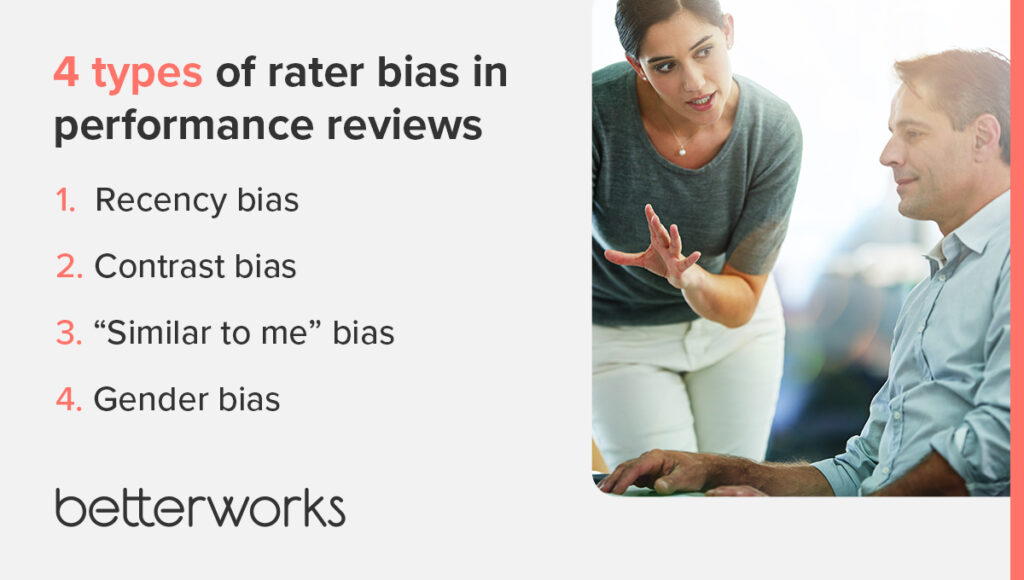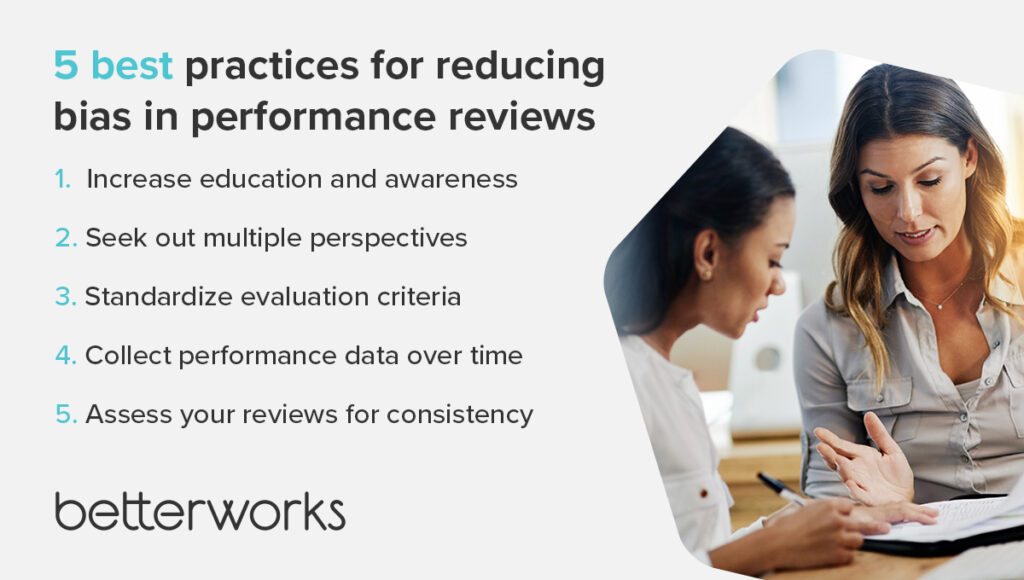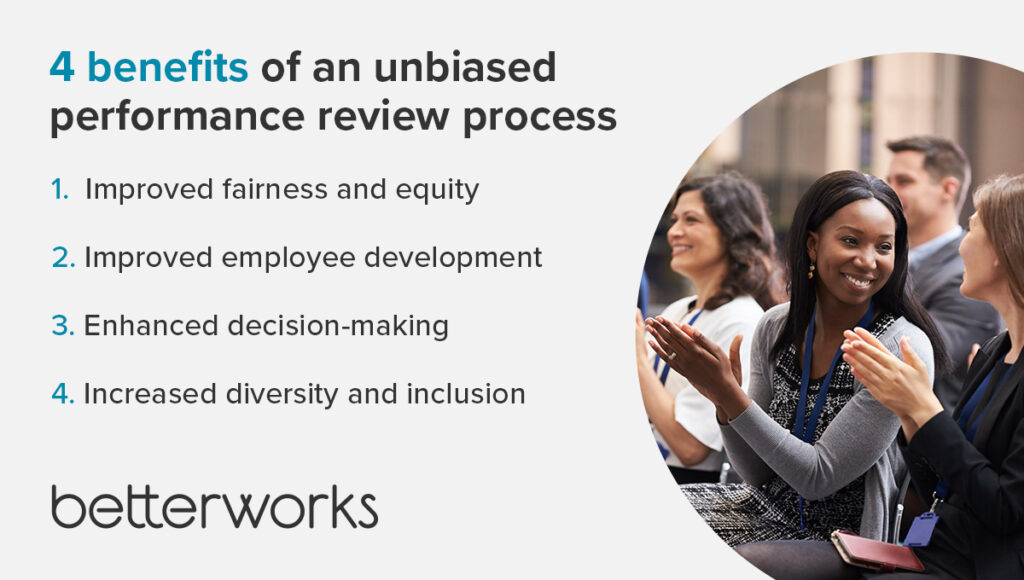- What is unconscious bias?
- The hidden bias problem: 4 types of rater bias
- How does bias affect employee development?
- 5 best practices for reducing bias in performance reviews
- 3 ways tech helps minimize performance appraisal biases
- 4 benefits of an unbiased performance review process
- Find the right partner to stop bias in performance reviews
Performance reviews are intended to objectively assess employee performance. But unconscious biases can subtly infiltrate the review process without managers realizing it, which leads to unfair judgments and unequal opportunities. By reducing bias in performance reviews, you can help managers provide fairer feedback so employees can perform better.
Employees are well aware of the harm bias can cause at work. More than half (55%) of employees responding to our 2023 State of Performance Enablement survey ranked fairness as the most important factor in the employee experience. Yet less than one-third of employees see performance reviews as being very fair and equitable — and that has consequences for the business. Those employees are more than twice as likely to report looking for work elsewhere.
When employers address potential performance review bias, they contribute to a more equitable and inviting workplace atmosphere where all employees can thrive. Learn how biased performance appraisals can negatively influence employees and how your organization can lay the foundation for objective reviews.
What is unconscious bias?
Unconscious bias refers to biases that individuals hold without being aware of them. These biases are ingrained in our subconscious, often through societal conditioning, and can unintentionally influence our perceptions, judgments, and actions. This is different from conscious bias, which individuals are aware of and can intentionally act on. Conscious biases are based on personal beliefs, stereotypes, or prejudices, and they can influence decision-making and behavior.
Whether conscious or unconscious, acting on bias can have serious consequences at work.
Unconscious bias can show up in a variety of ways. These include favoring people we feel are similar to us, making assumptions based on stereotypes, and not treating certain groups the same way as others. Unconscious bias can affect hiring, promotions, and performance evaluations. For example, a manager may favor job candidates or employees who share similar backgrounds or experiences. This can lead to less diversity, as dissimilar people aren’t hired or miss out on key assignments or promotion opportunities. Such overlooked employees are more likely to depart the workforce.
The hidden bias problem: 4 types of rater bias
During performance reviews, managers may inadvertently introduce biases that can impact the evaluation process. Recognizing and addressing these common biases is crucial for providing accurate and fair performance reviews. Here are four common types of bias that show up in performance management processes.
Recency bias
People tend to remember and focus on recent events or behaviors. This tendency can negatively influence their judgment during evaluations. When managers overweight recent events or behaviors when assessing performance, they can overlook earlier achievements or downplay performance improvement. This bias can lead to inaccurate and incomplete evaluations, as managers fail to consider the employee’s full performance record over the evaluation period.
Relying on memory can shape a manager’s perceptions of the past, too, says Caitlin Collins, organizational psychologist and Betterworks program strategy director. “Our memories fail us,” she says. “When we recall things, we tie emotions to them, whether we were really upset about an event or we were overly happy.”
The passage of time clouds our perceptions, potentially leading to an unfair or inaccurate performance appraisal process. For example, an employee who recently completed a big project might receive a higher rating than an employee who did the same thing nine months ago.
Contrast bias
We often make judgments based on how people differ from each other instead of considering their individual qualities. This is known as contrast bias, and it’s an inclination to assess things or people in relation to a nearby reference point instead of by objective measures.
When managers compare employees against co-workers instead of evaluating them on their individual performance against expectations, this contrast bias can lead to unfair evaluations. For example, an employee is harshly judged because the manager is comparing them against an unusually high-performing colleague rather than against the expectations for their job role. The evaluated employee might have performed adequately by objective measures, but the manager labels their performance as subpar because of this bias.
“Similar to me” bias
This bias, also known as affiliation bias, happens when we feel more comfortable and connected with people who are like us. This closeness can influence our judgments and evaluations. “We tend to be more positive toward people that we relate to better,” Caitlin says.
This bias can lead to inflated ratings for like-minded employees, even when they don’t reflect the employee’s actual performance against established expectations. Conversely, employees who are different from their manager may be at a disadvantage, as their unique qualities or perspectives might not be fully appreciated or recognized.
Gender bias
Gender bias occurs when people are judged unfairly according to stereotypes, prejudices, or societal expectations related to gender. Gender prejudice has many forms, including when people undervalue women’s skills or when managers use different criteria or hold different expectations for people depending on their gender.
Research has shown significant differences in the types of performance feedback men and women receive from their managers. One study found that women were 1.4 times as likely as men to receive critical subjective feedback. Another study found that reviewers tend to prioritize niceness when reviewing women, which can reinforce gender stereotypes and prevent women from getting the constructive feedback they need to grow their careers.
However gender bias manifests, the result is that certain employees are judged based on subjective and unfair qualities rather than on their abilities, skills, or potential.

How does bias affect employee development?
The effects of bias extend beyond performance appraisal meetings and can affect an employee’s long-term development — or lack thereof. Unfair and subjective assessments can slow or harm employee growth, ultimately hurting performance. Here are a few ways bias in performance reviews compounds over time.
Limited opportunities
Bias in performance reviews can cause certain employees to be disregarded or overlooked, which means they receive fewer opportunities to advance. This means they’re less likely to receive significant assignments, promotions, and other career growth opportunities.
Disengagement
When employees feel unfairly treated during performance evaluations, they can disengage from work. “They might get really frustrated with the manager or with the process,” Caitlin says. Disengaged employees are less happy and productive, and they’re more likely to leave, increasing turnover in your organization.
Inequality and unfair treatment
Biased performance reviews create disparate outcomes for certain groups of people, such as minorities or women. These outcomes are bad for their professional development and create liabilities for the organization.
Skills gaps and stunted growth
Biased performance reviews can prevent managers from properly identifying employee skills and potential. This leads to less effective professional growth and skills development for these workers. The result is a lack of advancement and productivity, ultimately harming the company’s prospects.
5 best practices for reducing bias in performance reviews
Building a healthy culture where employees can thrive requires organizations to create performance review processes that prevent and minimize bias. Here are best practices to minimize the influence of unconscious bias, promote transparency, and foster a culture of continuous feedback and development.
Increase education and awareness
Managers need to understand how unconscious bias manifests and how it can affect performance reviews. With this knowledge, managers can become more self-aware and mitigate their biases. “The biggest thing is just to be cognizant of it,” Caitlin says. “The more you reflect on things, the more you increase your own neuroplasticity.”
Provide unconscious bias training to managers through workshops, discussions, or case studies. Include a discussion of why employee evaluations need to be fair and unbiased. Additionally, managers should receive performance feedback so they can improve their evaluations and address their biases.
Seek out multiple perspectives
Encourage managers to collect feedback from multiple sources when evaluating employee performance. This can include input from peers, subordinates, and other stakeholders who have worked closely with the employee. By considering diverse perspectives, managers gain a more balanced view of employee performance and reduce the impact of any individual bias. Our 2023 State of Performance Enablement report showed that employees who had feedback from team leaders and members included in reviews were 2.5 times less likely to report bias. Those who had no ability for teams to give them performance feedback were 4.5 times more likely to say they saw bias in the system.
Standardize evaluation criteria
Evaluations shouldn’t be left to each manager’s whims or self-selected criteria. When that occurs, evaluations are inconsistent and more likely to include preventable biases. Standardize evaluations with clear and specific metrics so managers can focus on measurable factors rather than subjective judgments.
Create rubrics that are based on job descriptions. This helps managers hold everyone accountable while recognizing that each employee has different expectations based on their role and experience. Standardizing performance criteria helps you identify top performers based on objective measurements.
Collect performance data over time
Managers can collect performance data over time by many means, including peer feedback, coaching notes, and regular check-ins with employees. This approach allows for a comprehensive and objective assessment of employee performance that mixes observations with data. Managers can reduce the impact of bias by having multiple data points over a longer period of time — preventing any one outlier from skewing the evaluation.
Much of this data should live in your performance management system. A tool like Betterworks, which integrates with systems of work and communication, can pull the right data points into a single source of truth for managers to access and rely on. Items to track include coaching notes, feedback from peers, and employee achievements, Caitlin says.
Assess your reviews for consistency
Objective evaluation processes are also consistent in design and execution, as this creates fairness and reduces the influence of unconscious or conscious bias. To review performance reviews for consistency, managers should compare evaluations across employees and timeframes. Look for unusual patterns or discrepancies.
“Proofread everything that you’re writing, and compare it to the other reviews that you’ve written,” Caitlin says, “and really self-reflect to say, ‘Does this look equal across the board? Is it well-balanced? Is it objective?’” Generative AI tools built into your performance management system can help highlight key trends and differences in reviews.

3 ways tech helps minimize performance appraisal biases
Every person has unconscious biases, and it can be hard not to act on them. Technology tools can support a fairer review process that assesses employees based on their actual performance. Here are three ways tech can help.
More objective assessments
Managers can leverage data and AI to create unbiased performance review processes. Algorithms can help managers quickly and objectively review employee performance data, including productivity metrics, project results, or customer feedback. This combination of relevant data, tech, and manager involvement ensures that evaluations are based on facts, not personal biases, while still allowing for human input. This helps remove subjectivity without making the review process too impersonal.
Benchmarking
AI and data help employers do comparative research and benchmarking to reduce prejudice in employee reviews. Algorithms can quickly compare an individual’s performance to applicable standards, like industry benchmarks or peer outcomes, to create unbiased evaluations. Benchmarking helps supervisors perform comprehensive, industry-relevant assessments without the risk of bias resulting from personal beliefs or preconceived notions.
Ongoing performance data
AI-powered platforms can collect and analyze real-time performance data to help managers provide objective feedback and insight throughout the year. This reduces the reliance on annual reviews and encourages performance conversations that are accurate and in the context of recent performance and growth. An ongoing, data-backed approach minimizes the impact of biases that may arise from limited or outdated information.
4 benefits of an unbiased performance review process
Reducing the effects of bias in performance reviews can transform your workforce. Feelings of belonging are up to 60 percentage points higher among employees who see their reviews as very fair and equitable, according to our 2023 State of Performance Enablement report.
Here are a few of the outcomes you can expect from reducing bias in the performance review process.
Improved fairness and equity
An equitable performance review process helps employees believe that they’re being judged fairly. By removing favoritism and discrimination, every worker receives an equal chance to be assessed on their abilities, efforts, and outcomes. This fosters a sense of trust and justice within the workforce.
Improved employee development
Fair appraisal systems help managers accurately assess and recognize their employees’ capabilities and areas needing improvement. When appraisals are based on clear-cut standards and information, managers can give constructive criticism that’s unbiased and addresses issues that help make employees better. From there, managers and staff can create tailored development plans and pursue advancement opportunities.
Enhanced decision-making
When performance reviews are objective and unbiased, company leaders make more informed decisions about promotions, compensation, and talent development. Talent decisions are based on skill and performance, encouraging employees to strive for excellence because their efforts will be rewarded.
Increased diversity and inclusion
A bias-free performance review system supports diversity, equity, and inclusion. Fair evaluations give employees, regardless of personal characteristics, the same chance to demonstrate their abilities and growth potential. The result is a diverse and inclusive work environment where employees feel respected and empowered — and an organization that enjoys better morale, retention, creativity, and innovation.

Find the right partner to stop bias in performance reviews
The right performance management system is more than a tool: it’s a partner in your mission to overcome unconscious bias in performance reviews.
Betterworks helps organizations establish standardized evaluation criteria and transparent goal setting. This helps reduce subjective biases and ensures that performance assessments are based on objective data and measurable outcomes.
Additionally, Betterworks facilitates continuous feedback and coaching conversations, promoting a culture of ongoing development and improvement. With our data-driven insights and analytics, Betterworks empowers organizations to identify and address potential biases, fostering a more equitable and inclusive performance review process.
Start today on creating fairer performance appraisal processes so your employees feel fairly treated, properly recognized for their efforts, and motivated to pursue their potential.
Want to learn more? Discover six best practices for performance review process improvement.
Get the performance review process right






